Due Diligence of the Galveston Main Wastewater Treatment Plant Project
VerifiedAdded on 2021/06/14
|12
|2714
|195
Report
AI Summary
This report provides a comprehensive due diligence analysis of the Galveston Main Wastewater Treatment Plant, focusing on vulnerability assessment and risk management. It examines the application of due diligence principles in the context of engineering projects, emphasizing the importance of legal compliance and effective decision-making. The report employs vulnerability analysis techniques to identify potential weaknesses in the plant's operations, including natural hazards, plant failures, and financial threats. It assesses organizational assets like personnel, equipment, and public image, while also detailing the threats faced by the plant, such as hurricanes and financial fluctuations. The study categorizes critical vulnerabilities into notional, physical, and personal aspects and proposes strategies like risk transfer and control. Furthermore, it discusses precautionary analysis, advocating for preventive measures to protect human health and the environment, and recommends specific actions such as constructing resilient structures, employing advanced sanitation technologies, elevating new buildings, and training employees. The report concludes with a call for proactive measures to mitigate risks and ensure the plant's continued operational effectiveness.
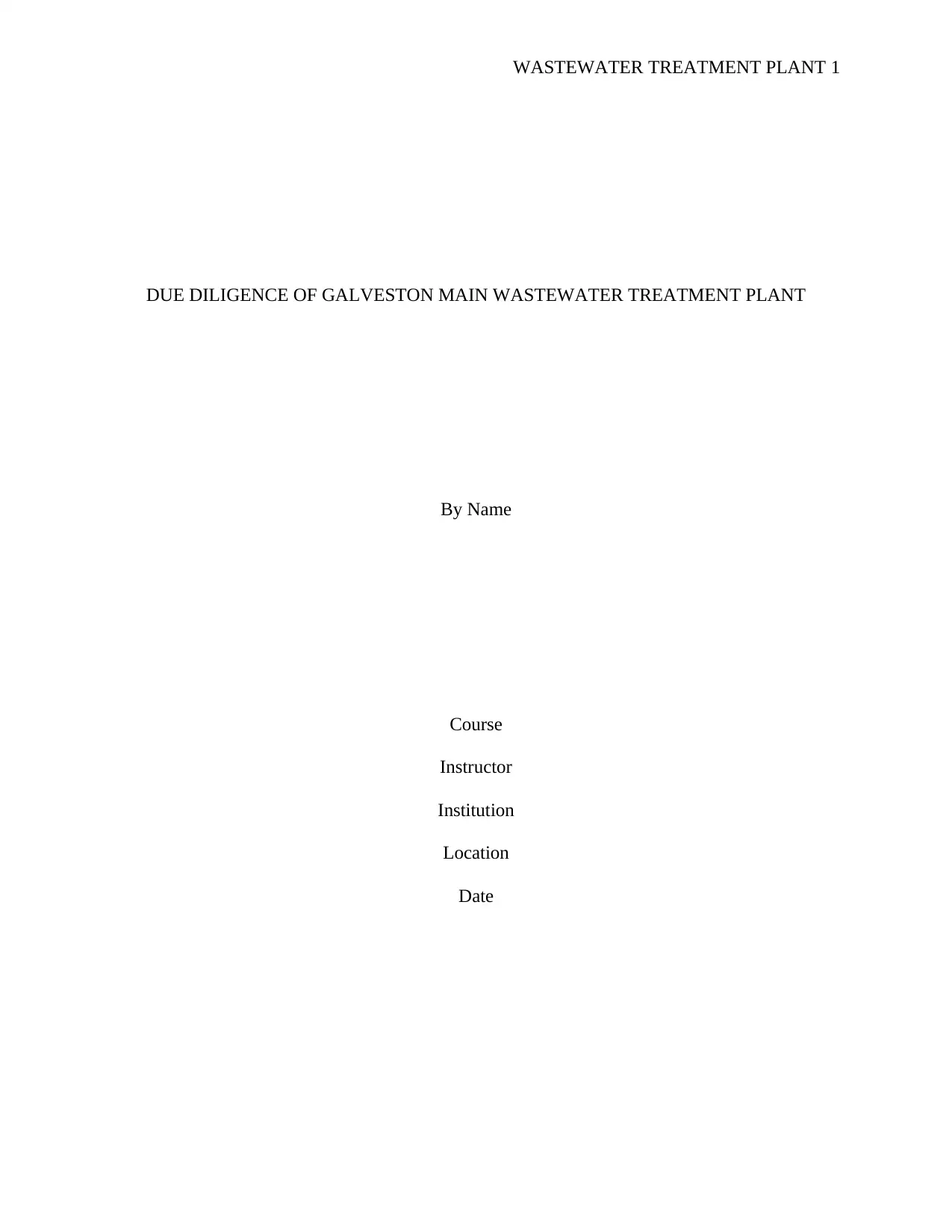
WASTEWATER TREATMENT PLANT 1
DUE DILIGENCE OF GALVESTON MAIN WASTEWATER TREATMENT PLANT
By Name
Course
Instructor
Institution
Location
Date
DUE DILIGENCE OF GALVESTON MAIN WASTEWATER TREATMENT PLANT
By Name
Course
Instructor
Institution
Location
Date
Paraphrase This Document
Need a fresh take? Get an instant paraphrase of this document with our AI Paraphraser
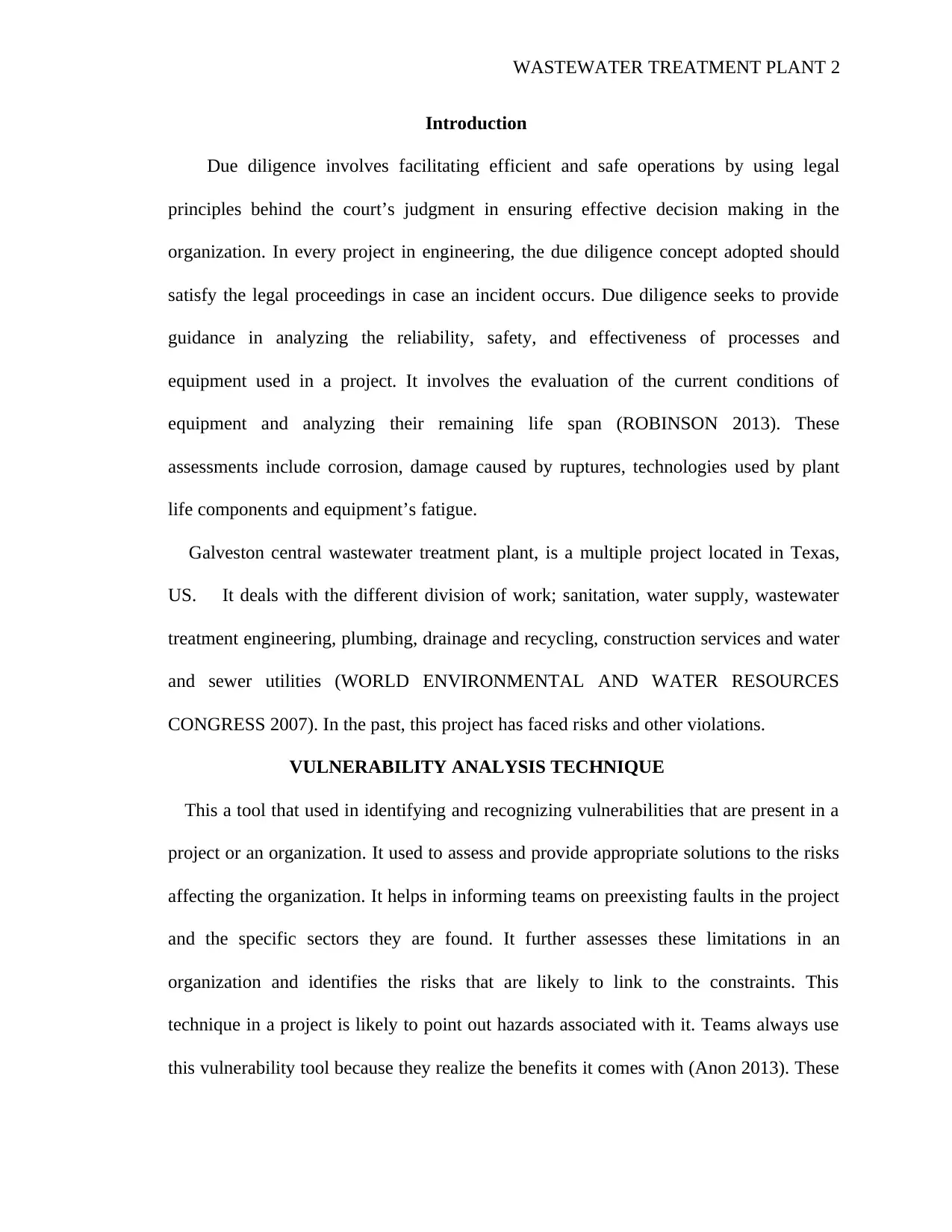
WASTEWATER TREATMENT PLANT 2
Introduction
Due diligence involves facilitating efficient and safe operations by using legal
principles behind the court’s judgment in ensuring effective decision making in the
organization. In every project in engineering, the due diligence concept adopted should
satisfy the legal proceedings in case an incident occurs. Due diligence seeks to provide
guidance in analyzing the reliability, safety, and effectiveness of processes and
equipment used in a project. It involves the evaluation of the current conditions of
equipment and analyzing their remaining life span (ROBINSON 2013). These
assessments include corrosion, damage caused by ruptures, technologies used by plant
life components and equipment’s fatigue.
Galveston central wastewater treatment plant, is a multiple project located in Texas,
US. It deals with the different division of work; sanitation, water supply, wastewater
treatment engineering, plumbing, drainage and recycling, construction services and water
and sewer utilities (WORLD ENVIRONMENTAL AND WATER RESOURCES
CONGRESS 2007). In the past, this project has faced risks and other violations.
VULNERABILITY ANALYSIS TECHNIQUE
This a tool that used in identifying and recognizing vulnerabilities that are present in a
project or an organization. It used to assess and provide appropriate solutions to the risks
affecting the organization. It helps in informing teams on preexisting faults in the project
and the specific sectors they are found. It further assesses these limitations in an
organization and identifies the risks that are likely to link to the constraints. This
technique in a project is likely to point out hazards associated with it. Teams always use
this vulnerability tool because they realize the benefits it comes with (Anon 2013). These
Introduction
Due diligence involves facilitating efficient and safe operations by using legal
principles behind the court’s judgment in ensuring effective decision making in the
organization. In every project in engineering, the due diligence concept adopted should
satisfy the legal proceedings in case an incident occurs. Due diligence seeks to provide
guidance in analyzing the reliability, safety, and effectiveness of processes and
equipment used in a project. It involves the evaluation of the current conditions of
equipment and analyzing their remaining life span (ROBINSON 2013). These
assessments include corrosion, damage caused by ruptures, technologies used by plant
life components and equipment’s fatigue.
Galveston central wastewater treatment plant, is a multiple project located in Texas,
US. It deals with the different division of work; sanitation, water supply, wastewater
treatment engineering, plumbing, drainage and recycling, construction services and water
and sewer utilities (WORLD ENVIRONMENTAL AND WATER RESOURCES
CONGRESS 2007). In the past, this project has faced risks and other violations.
VULNERABILITY ANALYSIS TECHNIQUE
This a tool that used in identifying and recognizing vulnerabilities that are present in a
project or an organization. It used to assess and provide appropriate solutions to the risks
affecting the organization. It helps in informing teams on preexisting faults in the project
and the specific sectors they are found. It further assesses these limitations in an
organization and identifies the risks that are likely to link to the constraints. This
technique in a project is likely to point out hazards associated with it. Teams always use
this vulnerability tool because they realize the benefits it comes with (Anon 2013). These
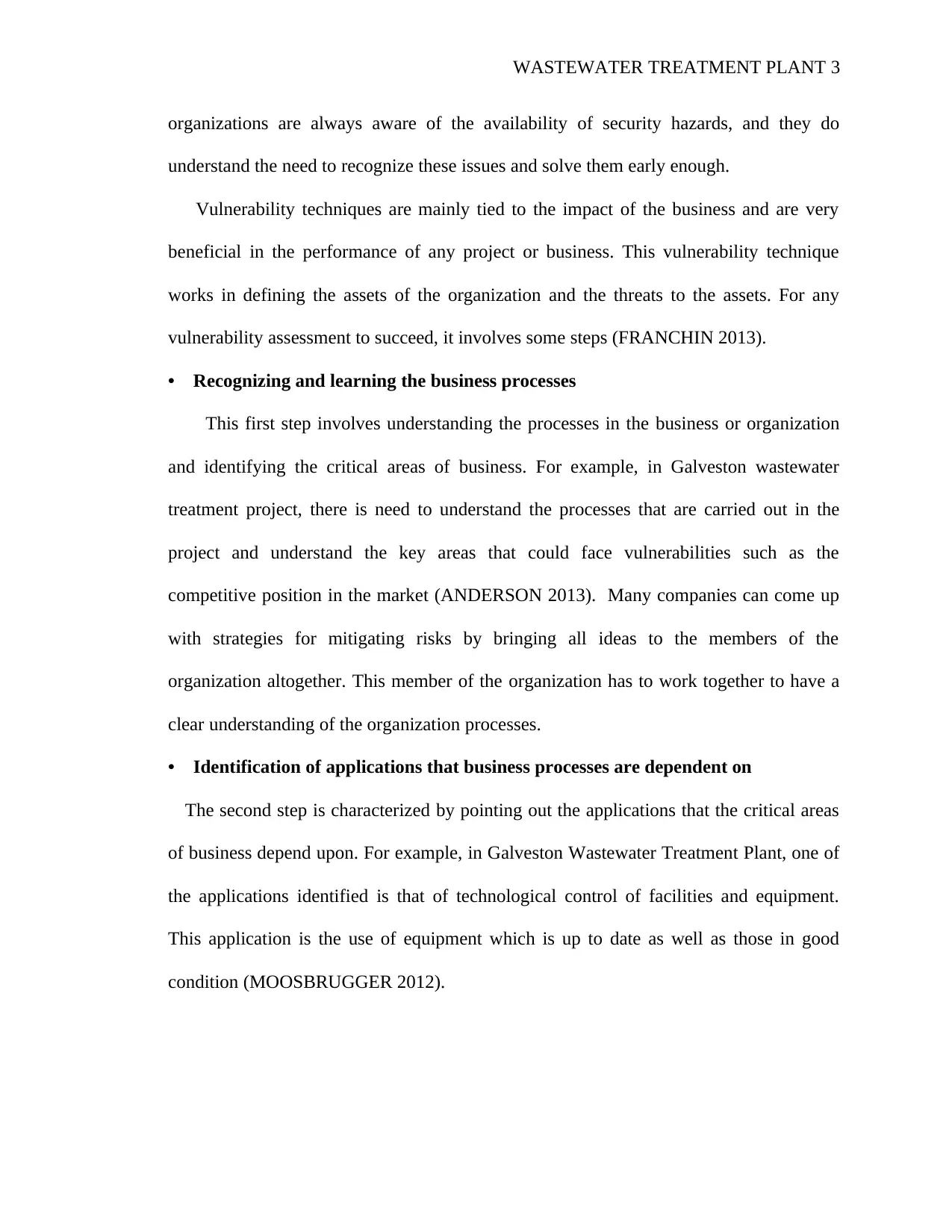
WASTEWATER TREATMENT PLANT 3
organizations are always aware of the availability of security hazards, and they do
understand the need to recognize these issues and solve them early enough.
Vulnerability techniques are mainly tied to the impact of the business and are very
beneficial in the performance of any project or business. This vulnerability technique
works in defining the assets of the organization and the threats to the assets. For any
vulnerability assessment to succeed, it involves some steps (FRANCHIN 2013).
• Recognizing and learning the business processes
This first step involves understanding the processes in the business or organization
and identifying the critical areas of business. For example, in Galveston wastewater
treatment project, there is need to understand the processes that are carried out in the
project and understand the key areas that could face vulnerabilities such as the
competitive position in the market (ANDERSON 2013). Many companies can come up
with strategies for mitigating risks by bringing all ideas to the members of the
organization altogether. This member of the organization has to work together to have a
clear understanding of the organization processes.
• Identification of applications that business processes are dependent on
The second step is characterized by pointing out the applications that the critical areas
of business depend upon. For example, in Galveston Wastewater Treatment Plant, one of
the applications identified is that of technological control of facilities and equipment.
This application is the use of equipment which is up to date as well as those in good
condition (MOOSBRUGGER 2012).
organizations are always aware of the availability of security hazards, and they do
understand the need to recognize these issues and solve them early enough.
Vulnerability techniques are mainly tied to the impact of the business and are very
beneficial in the performance of any project or business. This vulnerability technique
works in defining the assets of the organization and the threats to the assets. For any
vulnerability assessment to succeed, it involves some steps (FRANCHIN 2013).
• Recognizing and learning the business processes
This first step involves understanding the processes in the business or organization
and identifying the critical areas of business. For example, in Galveston wastewater
treatment project, there is need to understand the processes that are carried out in the
project and understand the key areas that could face vulnerabilities such as the
competitive position in the market (ANDERSON 2013). Many companies can come up
with strategies for mitigating risks by bringing all ideas to the members of the
organization altogether. This member of the organization has to work together to have a
clear understanding of the organization processes.
• Identification of applications that business processes are dependent on
The second step is characterized by pointing out the applications that the critical areas
of business depend upon. For example, in Galveston Wastewater Treatment Plant, one of
the applications identified is that of technological control of facilities and equipment.
This application is the use of equipment which is up to date as well as those in good
condition (MOOSBRUGGER 2012).
⊘ This is a preview!⊘
Do you want full access?
Subscribe today to unlock all pages.

Trusted by 1+ million students worldwide
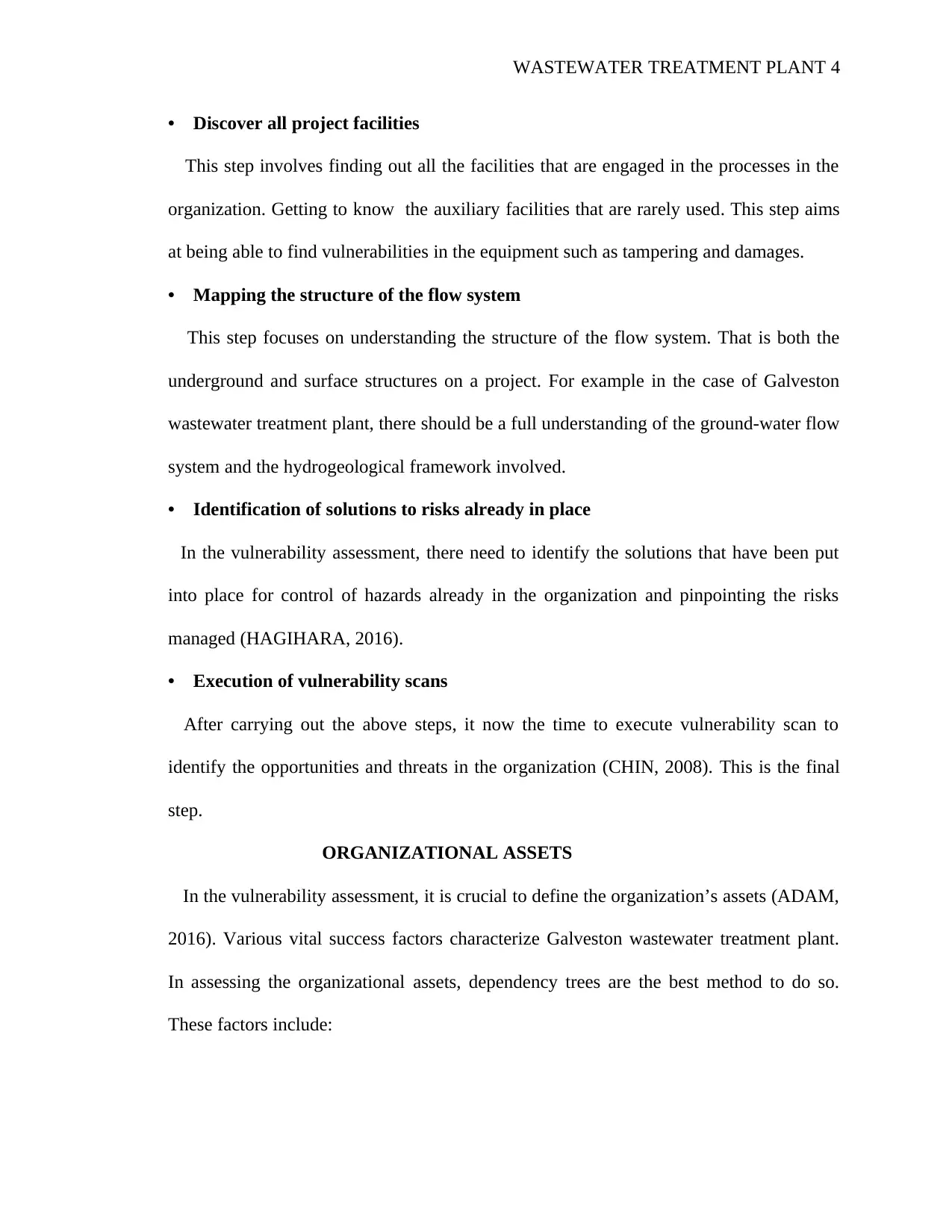
WASTEWATER TREATMENT PLANT 4
• Discover all project facilities
This step involves finding out all the facilities that are engaged in the processes in the
organization. Getting to know the auxiliary facilities that are rarely used. This step aims
at being able to find vulnerabilities in the equipment such as tampering and damages.
• Mapping the structure of the flow system
This step focuses on understanding the structure of the flow system. That is both the
underground and surface structures on a project. For example in the case of Galveston
wastewater treatment plant, there should be a full understanding of the ground-water flow
system and the hydrogeological framework involved.
• Identification of solutions to risks already in place
In the vulnerability assessment, there need to identify the solutions that have been put
into place for control of hazards already in the organization and pinpointing the risks
managed (HAGIHARA, 2016).
• Execution of vulnerability scans
After carrying out the above steps, it now the time to execute vulnerability scan to
identify the opportunities and threats in the organization (CHIN, 2008). This is the final
step.
ORGANIZATIONAL ASSETS
In the vulnerability assessment, it is crucial to define the organization’s assets (ADAM,
2016). Various vital success factors characterize Galveston wastewater treatment plant.
In assessing the organizational assets, dependency trees are the best method to do so.
These factors include:
• Discover all project facilities
This step involves finding out all the facilities that are engaged in the processes in the
organization. Getting to know the auxiliary facilities that are rarely used. This step aims
at being able to find vulnerabilities in the equipment such as tampering and damages.
• Mapping the structure of the flow system
This step focuses on understanding the structure of the flow system. That is both the
underground and surface structures on a project. For example in the case of Galveston
wastewater treatment plant, there should be a full understanding of the ground-water flow
system and the hydrogeological framework involved.
• Identification of solutions to risks already in place
In the vulnerability assessment, there need to identify the solutions that have been put
into place for control of hazards already in the organization and pinpointing the risks
managed (HAGIHARA, 2016).
• Execution of vulnerability scans
After carrying out the above steps, it now the time to execute vulnerability scan to
identify the opportunities and threats in the organization (CHIN, 2008). This is the final
step.
ORGANIZATIONAL ASSETS
In the vulnerability assessment, it is crucial to define the organization’s assets (ADAM,
2016). Various vital success factors characterize Galveston wastewater treatment plant.
In assessing the organizational assets, dependency trees are the best method to do so.
These factors include:
Paraphrase This Document
Need a fresh take? Get an instant paraphrase of this document with our AI Paraphraser
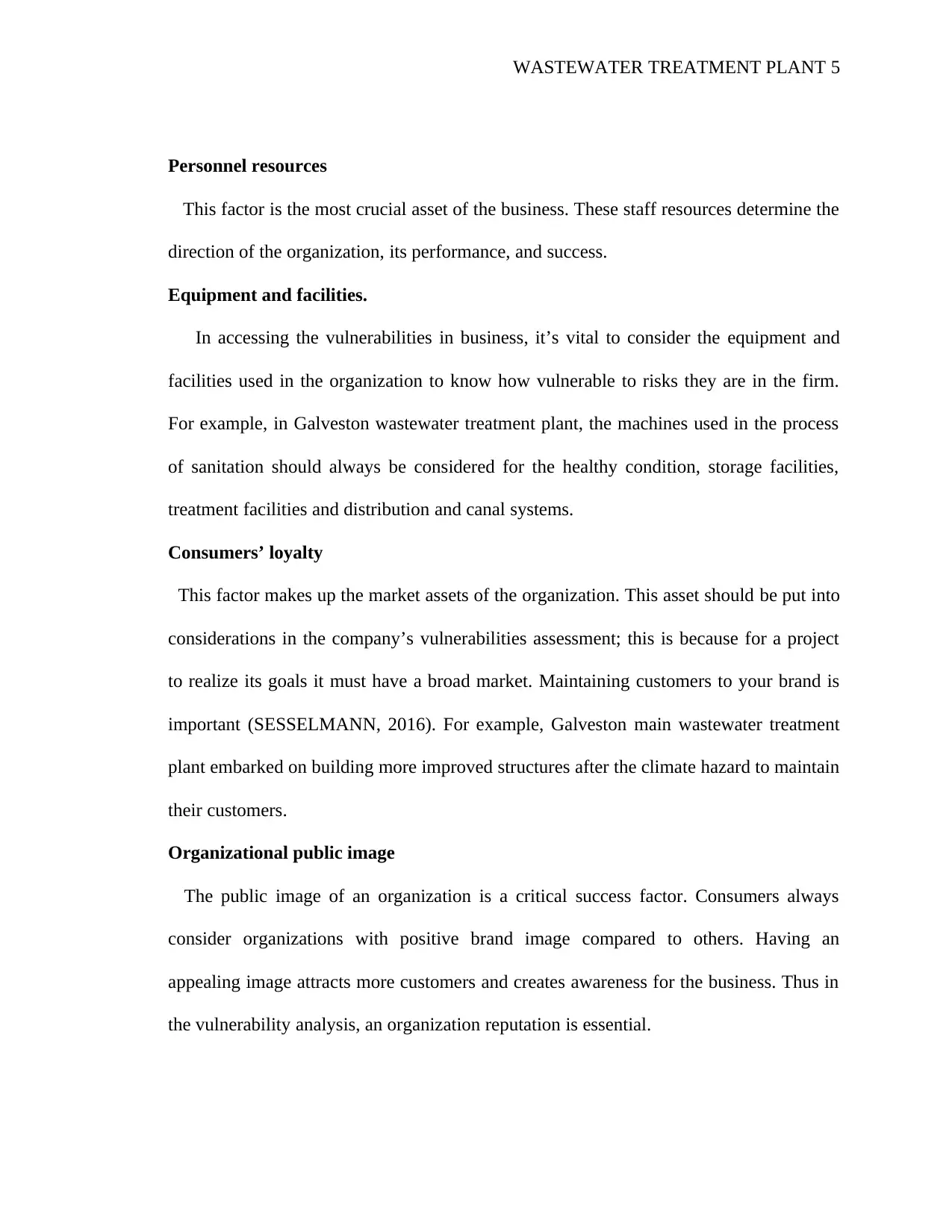
WASTEWATER TREATMENT PLANT 5
Personnel resources
This factor is the most crucial asset of the business. These staff resources determine the
direction of the organization, its performance, and success.
Equipment and facilities.
In accessing the vulnerabilities in business, it’s vital to consider the equipment and
facilities used in the organization to know how vulnerable to risks they are in the firm.
For example, in Galveston wastewater treatment plant, the machines used in the process
of sanitation should always be considered for the healthy condition, storage facilities,
treatment facilities and distribution and canal systems.
Consumers’ loyalty
This factor makes up the market assets of the organization. This asset should be put into
considerations in the company’s vulnerabilities assessment; this is because for a project
to realize its goals it must have a broad market. Maintaining customers to your brand is
important (SESSELMANN, 2016). For example, Galveston main wastewater treatment
plant embarked on building more improved structures after the climate hazard to maintain
their customers.
Organizational public image
The public image of an organization is a critical success factor. Consumers always
consider organizations with positive brand image compared to others. Having an
appealing image attracts more customers and creates awareness for the business. Thus in
the vulnerability analysis, an organization reputation is essential.
Personnel resources
This factor is the most crucial asset of the business. These staff resources determine the
direction of the organization, its performance, and success.
Equipment and facilities.
In accessing the vulnerabilities in business, it’s vital to consider the equipment and
facilities used in the organization to know how vulnerable to risks they are in the firm.
For example, in Galveston wastewater treatment plant, the machines used in the process
of sanitation should always be considered for the healthy condition, storage facilities,
treatment facilities and distribution and canal systems.
Consumers’ loyalty
This factor makes up the market assets of the organization. This asset should be put into
considerations in the company’s vulnerabilities assessment; this is because for a project
to realize its goals it must have a broad market. Maintaining customers to your brand is
important (SESSELMANN, 2016). For example, Galveston main wastewater treatment
plant embarked on building more improved structures after the climate hazard to maintain
their customers.
Organizational public image
The public image of an organization is a critical success factor. Consumers always
consider organizations with positive brand image compared to others. Having an
appealing image attracts more customers and creates awareness for the business. Thus in
the vulnerability analysis, an organization reputation is essential.
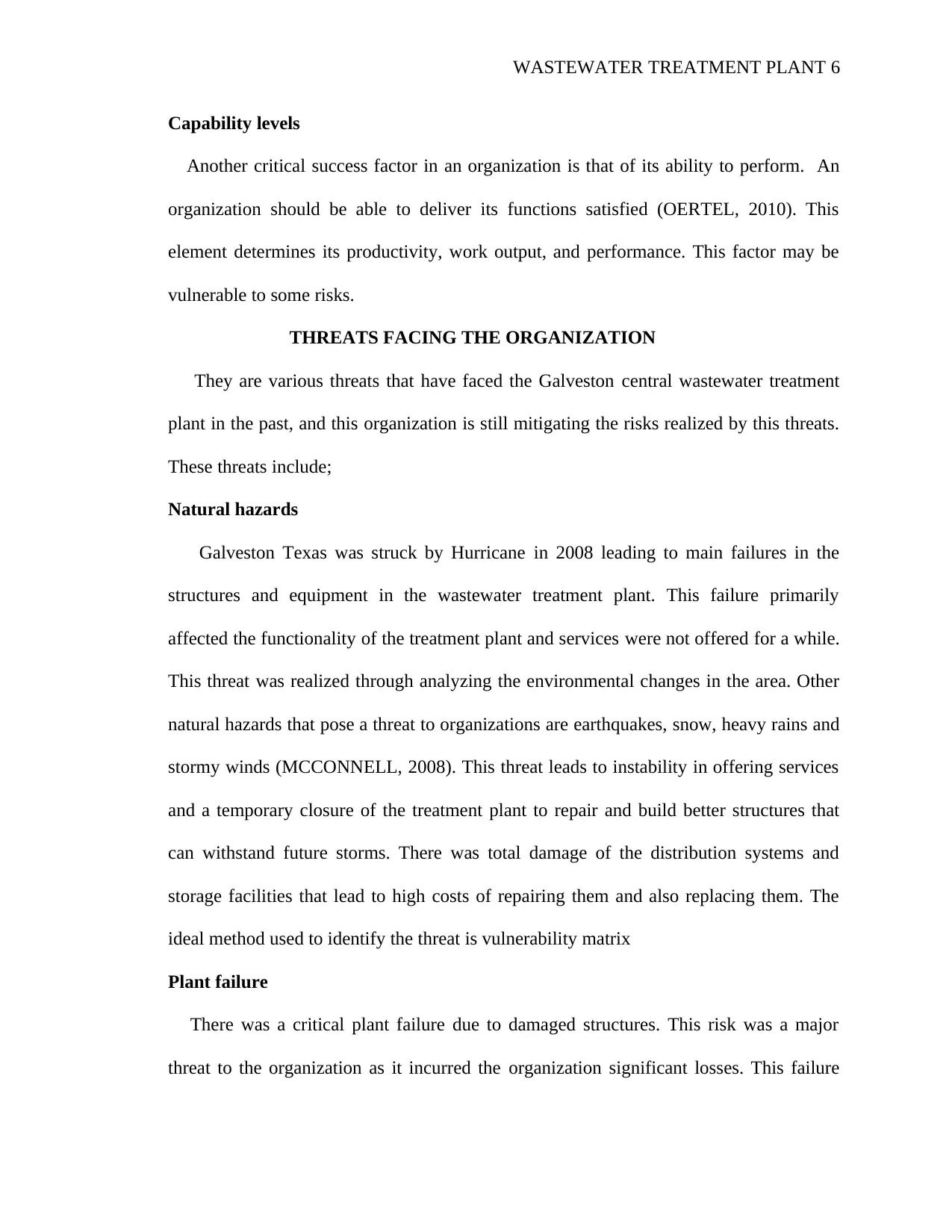
WASTEWATER TREATMENT PLANT 6
Capability levels
Another critical success factor in an organization is that of its ability to perform. An
organization should be able to deliver its functions satisfied (OERTEL, 2010). This
element determines its productivity, work output, and performance. This factor may be
vulnerable to some risks.
THREATS FACING THE ORGANIZATION
They are various threats that have faced the Galveston central wastewater treatment
plant in the past, and this organization is still mitigating the risks realized by this threats.
These threats include;
Natural hazards
Galveston Texas was struck by Hurricane in 2008 leading to main failures in the
structures and equipment in the wastewater treatment plant. This failure primarily
affected the functionality of the treatment plant and services were not offered for a while.
This threat was realized through analyzing the environmental changes in the area. Other
natural hazards that pose a threat to organizations are earthquakes, snow, heavy rains and
stormy winds (MCCONNELL, 2008). This threat leads to instability in offering services
and a temporary closure of the treatment plant to repair and build better structures that
can withstand future storms. There was total damage of the distribution systems and
storage facilities that lead to high costs of repairing them and also replacing them. The
ideal method used to identify the threat is vulnerability matrix
Plant failure
There was a critical plant failure due to damaged structures. This risk was a major
threat to the organization as it incurred the organization significant losses. This failure
Capability levels
Another critical success factor in an organization is that of its ability to perform. An
organization should be able to deliver its functions satisfied (OERTEL, 2010). This
element determines its productivity, work output, and performance. This factor may be
vulnerable to some risks.
THREATS FACING THE ORGANIZATION
They are various threats that have faced the Galveston central wastewater treatment
plant in the past, and this organization is still mitigating the risks realized by this threats.
These threats include;
Natural hazards
Galveston Texas was struck by Hurricane in 2008 leading to main failures in the
structures and equipment in the wastewater treatment plant. This failure primarily
affected the functionality of the treatment plant and services were not offered for a while.
This threat was realized through analyzing the environmental changes in the area. Other
natural hazards that pose a threat to organizations are earthquakes, snow, heavy rains and
stormy winds (MCCONNELL, 2008). This threat leads to instability in offering services
and a temporary closure of the treatment plant to repair and build better structures that
can withstand future storms. There was total damage of the distribution systems and
storage facilities that lead to high costs of repairing them and also replacing them. The
ideal method used to identify the threat is vulnerability matrix
Plant failure
There was a critical plant failure due to damaged structures. This risk was a major
threat to the organization as it incurred the organization significant losses. This failure
⊘ This is a preview!⊘
Do you want full access?
Subscribe today to unlock all pages.

Trusted by 1+ million students worldwide
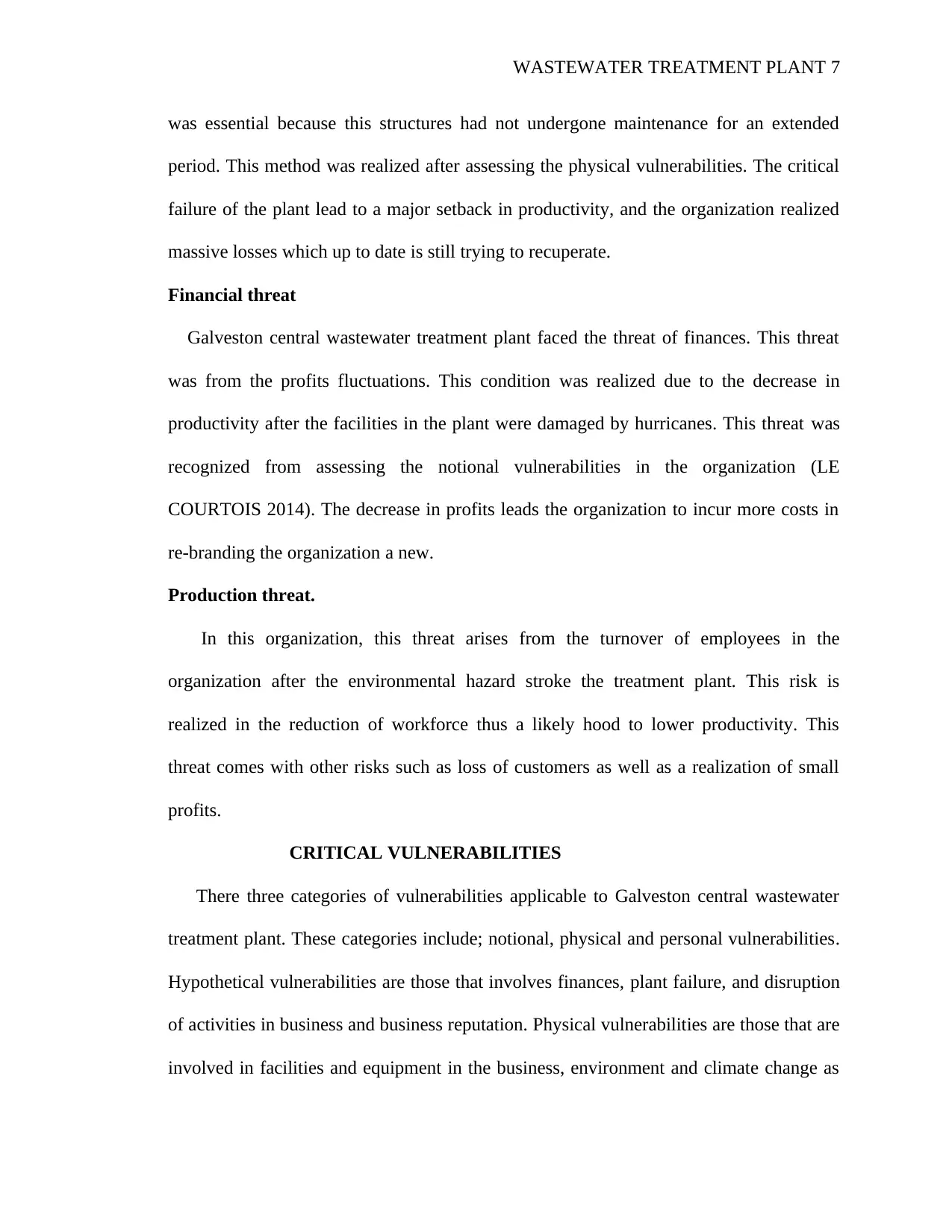
WASTEWATER TREATMENT PLANT 7
was essential because this structures had not undergone maintenance for an extended
period. This method was realized after assessing the physical vulnerabilities. The critical
failure of the plant lead to a major setback in productivity, and the organization realized
massive losses which up to date is still trying to recuperate.
Financial threat
Galveston central wastewater treatment plant faced the threat of finances. This threat
was from the profits fluctuations. This condition was realized due to the decrease in
productivity after the facilities in the plant were damaged by hurricanes. This threat was
recognized from assessing the notional vulnerabilities in the organization (LE
COURTOIS 2014). The decrease in profits leads the organization to incur more costs in
re-branding the organization a new.
Production threat.
In this organization, this threat arises from the turnover of employees in the
organization after the environmental hazard stroke the treatment plant. This risk is
realized in the reduction of workforce thus a likely hood to lower productivity. This
threat comes with other risks such as loss of customers as well as a realization of small
profits.
CRITICAL VULNERABILITIES
There three categories of vulnerabilities applicable to Galveston central wastewater
treatment plant. These categories include; notional, physical and personal vulnerabilities.
Hypothetical vulnerabilities are those that involves finances, plant failure, and disruption
of activities in business and business reputation. Physical vulnerabilities are those that are
involved in facilities and equipment in the business, environment and climate change as
was essential because this structures had not undergone maintenance for an extended
period. This method was realized after assessing the physical vulnerabilities. The critical
failure of the plant lead to a major setback in productivity, and the organization realized
massive losses which up to date is still trying to recuperate.
Financial threat
Galveston central wastewater treatment plant faced the threat of finances. This threat
was from the profits fluctuations. This condition was realized due to the decrease in
productivity after the facilities in the plant were damaged by hurricanes. This threat was
recognized from assessing the notional vulnerabilities in the organization (LE
COURTOIS 2014). The decrease in profits leads the organization to incur more costs in
re-branding the organization a new.
Production threat.
In this organization, this threat arises from the turnover of employees in the
organization after the environmental hazard stroke the treatment plant. This risk is
realized in the reduction of workforce thus a likely hood to lower productivity. This
threat comes with other risks such as loss of customers as well as a realization of small
profits.
CRITICAL VULNERABILITIES
There three categories of vulnerabilities applicable to Galveston central wastewater
treatment plant. These categories include; notional, physical and personal vulnerabilities.
Hypothetical vulnerabilities are those that involves finances, plant failure, and disruption
of activities in business and business reputation. Physical vulnerabilities are those that are
involved in facilities and equipment in the business, environment and climate change as
Paraphrase This Document
Need a fresh take? Get an instant paraphrase of this document with our AI Paraphraser
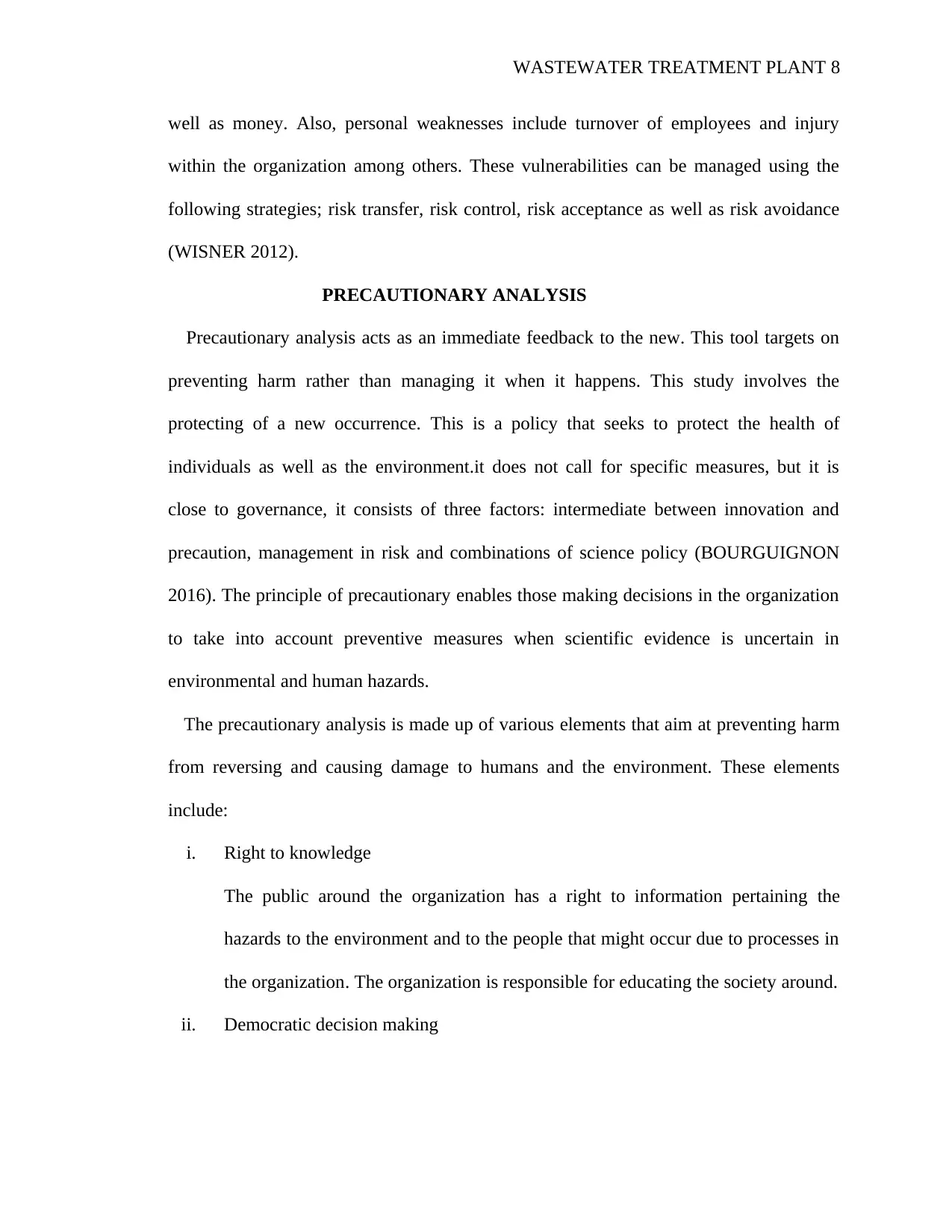
WASTEWATER TREATMENT PLANT 8
well as money. Also, personal weaknesses include turnover of employees and injury
within the organization among others. These vulnerabilities can be managed using the
following strategies; risk transfer, risk control, risk acceptance as well as risk avoidance
(WISNER 2012).
PRECAUTIONARY ANALYSIS
Precautionary analysis acts as an immediate feedback to the new. This tool targets on
preventing harm rather than managing it when it happens. This study involves the
protecting of a new occurrence. This is a policy that seeks to protect the health of
individuals as well as the environment.it does not call for specific measures, but it is
close to governance, it consists of three factors: intermediate between innovation and
precaution, management in risk and combinations of science policy (BOURGUIGNON
2016). The principle of precautionary enables those making decisions in the organization
to take into account preventive measures when scientific evidence is uncertain in
environmental and human hazards.
The precautionary analysis is made up of various elements that aim at preventing harm
from reversing and causing damage to humans and the environment. These elements
include:
i. Right to knowledge
The public around the organization has a right to information pertaining the
hazards to the environment and to the people that might occur due to processes in
the organization. The organization is responsible for educating the society around.
ii. Democratic decision making
well as money. Also, personal weaknesses include turnover of employees and injury
within the organization among others. These vulnerabilities can be managed using the
following strategies; risk transfer, risk control, risk acceptance as well as risk avoidance
(WISNER 2012).
PRECAUTIONARY ANALYSIS
Precautionary analysis acts as an immediate feedback to the new. This tool targets on
preventing harm rather than managing it when it happens. This study involves the
protecting of a new occurrence. This is a policy that seeks to protect the health of
individuals as well as the environment.it does not call for specific measures, but it is
close to governance, it consists of three factors: intermediate between innovation and
precaution, management in risk and combinations of science policy (BOURGUIGNON
2016). The principle of precautionary enables those making decisions in the organization
to take into account preventive measures when scientific evidence is uncertain in
environmental and human hazards.
The precautionary analysis is made up of various elements that aim at preventing harm
from reversing and causing damage to humans and the environment. These elements
include:
i. Right to knowledge
The public around the organization has a right to information pertaining the
hazards to the environment and to the people that might occur due to processes in
the organization. The organization is responsible for educating the society around.
ii. Democratic decision making
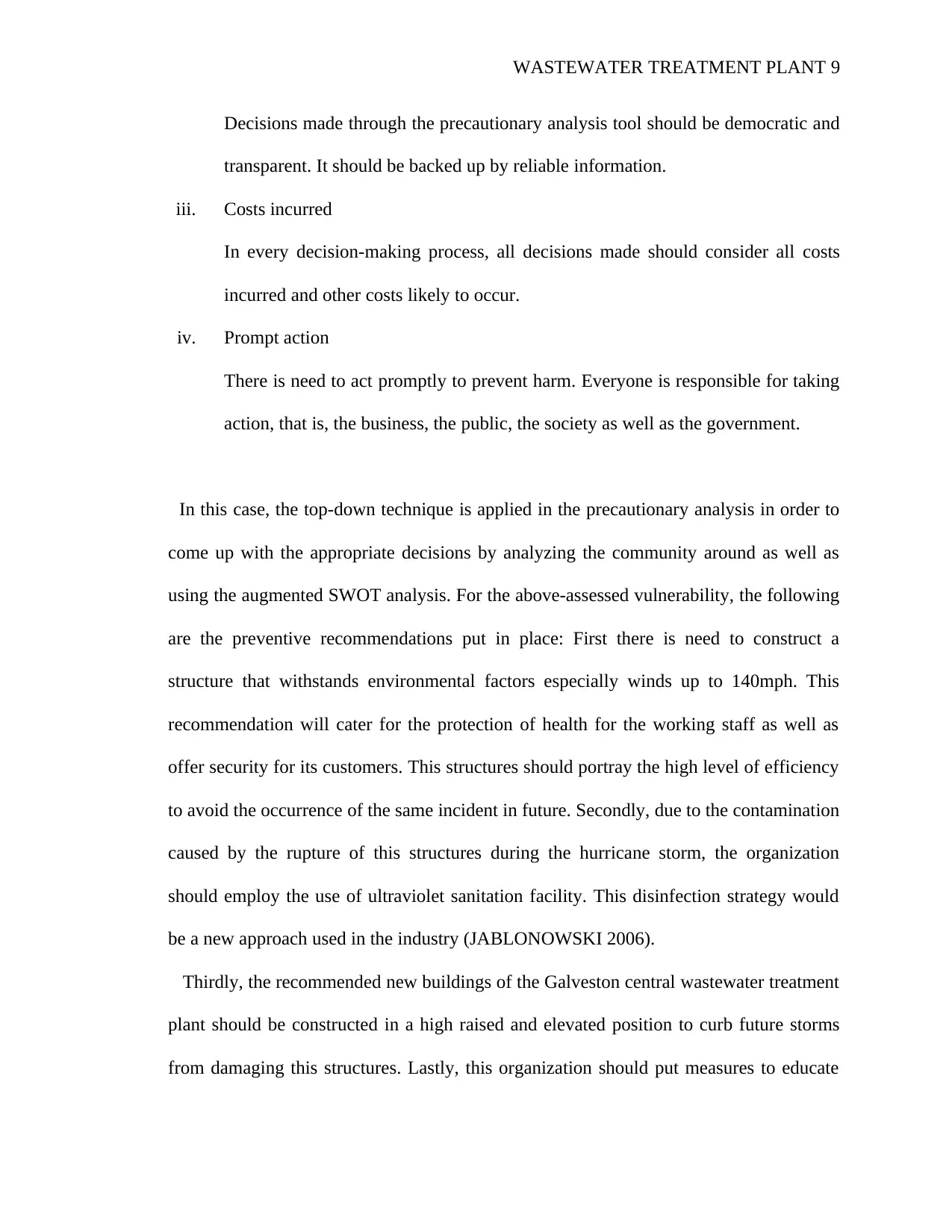
WASTEWATER TREATMENT PLANT 9
Decisions made through the precautionary analysis tool should be democratic and
transparent. It should be backed up by reliable information.
iii. Costs incurred
In every decision-making process, all decisions made should consider all costs
incurred and other costs likely to occur.
iv. Prompt action
There is need to act promptly to prevent harm. Everyone is responsible for taking
action, that is, the business, the public, the society as well as the government.
In this case, the top-down technique is applied in the precautionary analysis in order to
come up with the appropriate decisions by analyzing the community around as well as
using the augmented SWOT analysis. For the above-assessed vulnerability, the following
are the preventive recommendations put in place: First there is need to construct a
structure that withstands environmental factors especially winds up to 140mph. This
recommendation will cater for the protection of health for the working staff as well as
offer security for its customers. This structures should portray the high level of efficiency
to avoid the occurrence of the same incident in future. Secondly, due to the contamination
caused by the rupture of this structures during the hurricane storm, the organization
should employ the use of ultraviolet sanitation facility. This disinfection strategy would
be a new approach used in the industry (JABLONOWSKI 2006).
Thirdly, the recommended new buildings of the Galveston central wastewater treatment
plant should be constructed in a high raised and elevated position to curb future storms
from damaging this structures. Lastly, this organization should put measures to educate
Decisions made through the precautionary analysis tool should be democratic and
transparent. It should be backed up by reliable information.
iii. Costs incurred
In every decision-making process, all decisions made should consider all costs
incurred and other costs likely to occur.
iv. Prompt action
There is need to act promptly to prevent harm. Everyone is responsible for taking
action, that is, the business, the public, the society as well as the government.
In this case, the top-down technique is applied in the precautionary analysis in order to
come up with the appropriate decisions by analyzing the community around as well as
using the augmented SWOT analysis. For the above-assessed vulnerability, the following
are the preventive recommendations put in place: First there is need to construct a
structure that withstands environmental factors especially winds up to 140mph. This
recommendation will cater for the protection of health for the working staff as well as
offer security for its customers. This structures should portray the high level of efficiency
to avoid the occurrence of the same incident in future. Secondly, due to the contamination
caused by the rupture of this structures during the hurricane storm, the organization
should employ the use of ultraviolet sanitation facility. This disinfection strategy would
be a new approach used in the industry (JABLONOWSKI 2006).
Thirdly, the recommended new buildings of the Galveston central wastewater treatment
plant should be constructed in a high raised and elevated position to curb future storms
from damaging this structures. Lastly, this organization should put measures to educate
⊘ This is a preview!⊘
Do you want full access?
Subscribe today to unlock all pages.

Trusted by 1+ million students worldwide
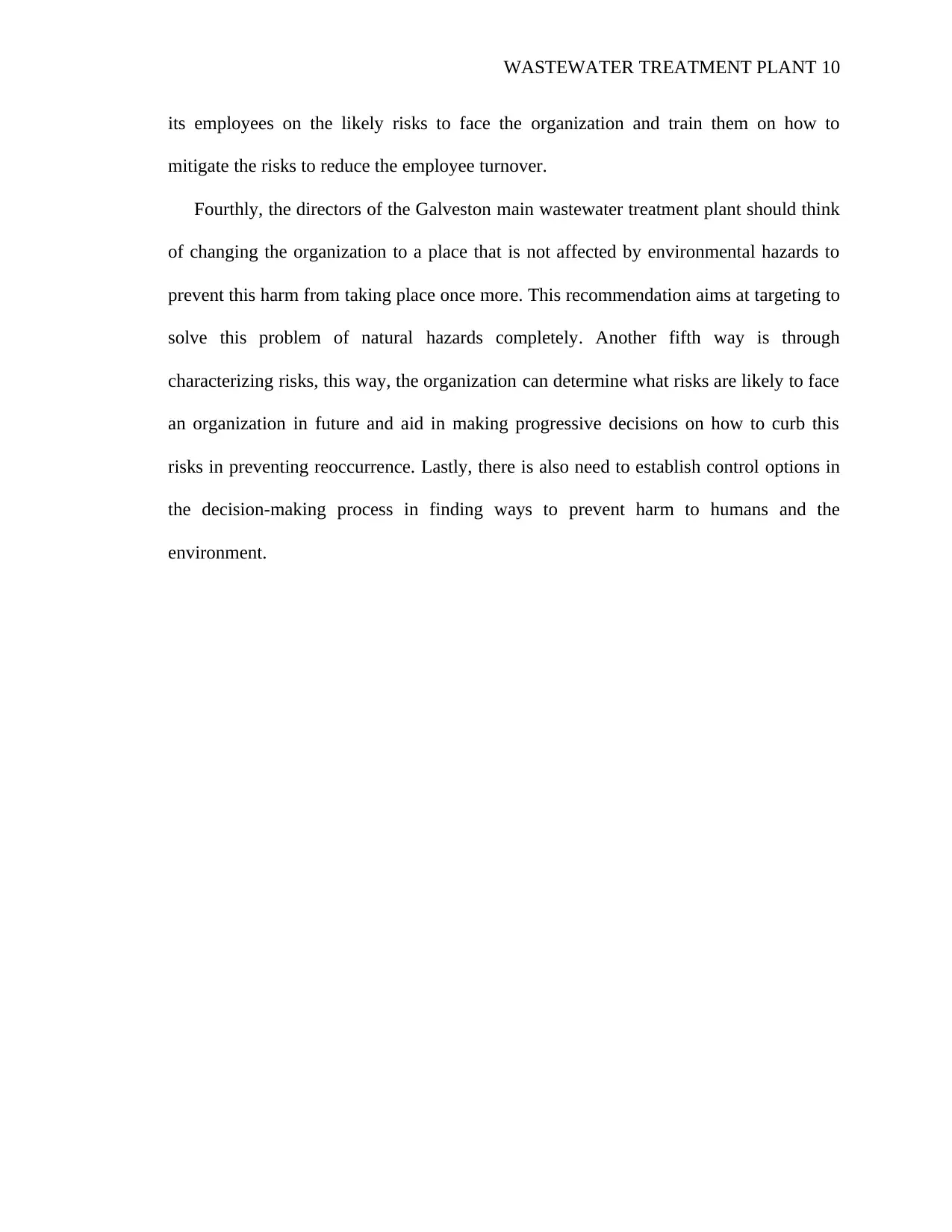
WASTEWATER TREATMENT PLANT 10
its employees on the likely risks to face the organization and train them on how to
mitigate the risks to reduce the employee turnover.
Fourthly, the directors of the Galveston main wastewater treatment plant should think
of changing the organization to a place that is not affected by environmental hazards to
prevent this harm from taking place once more. This recommendation aims at targeting to
solve this problem of natural hazards completely. Another fifth way is through
characterizing risks, this way, the organization can determine what risks are likely to face
an organization in future and aid in making progressive decisions on how to curb this
risks in preventing reoccurrence. Lastly, there is also need to establish control options in
the decision-making process in finding ways to prevent harm to humans and the
environment.
its employees on the likely risks to face the organization and train them on how to
mitigate the risks to reduce the employee turnover.
Fourthly, the directors of the Galveston main wastewater treatment plant should think
of changing the organization to a place that is not affected by environmental hazards to
prevent this harm from taking place once more. This recommendation aims at targeting to
solve this problem of natural hazards completely. Another fifth way is through
characterizing risks, this way, the organization can determine what risks are likely to face
an organization in future and aid in making progressive decisions on how to curb this
risks in preventing reoccurrence. Lastly, there is also need to establish control options in
the decision-making process in finding ways to prevent harm to humans and the
environment.
Paraphrase This Document
Need a fresh take? Get an instant paraphrase of this document with our AI Paraphraser
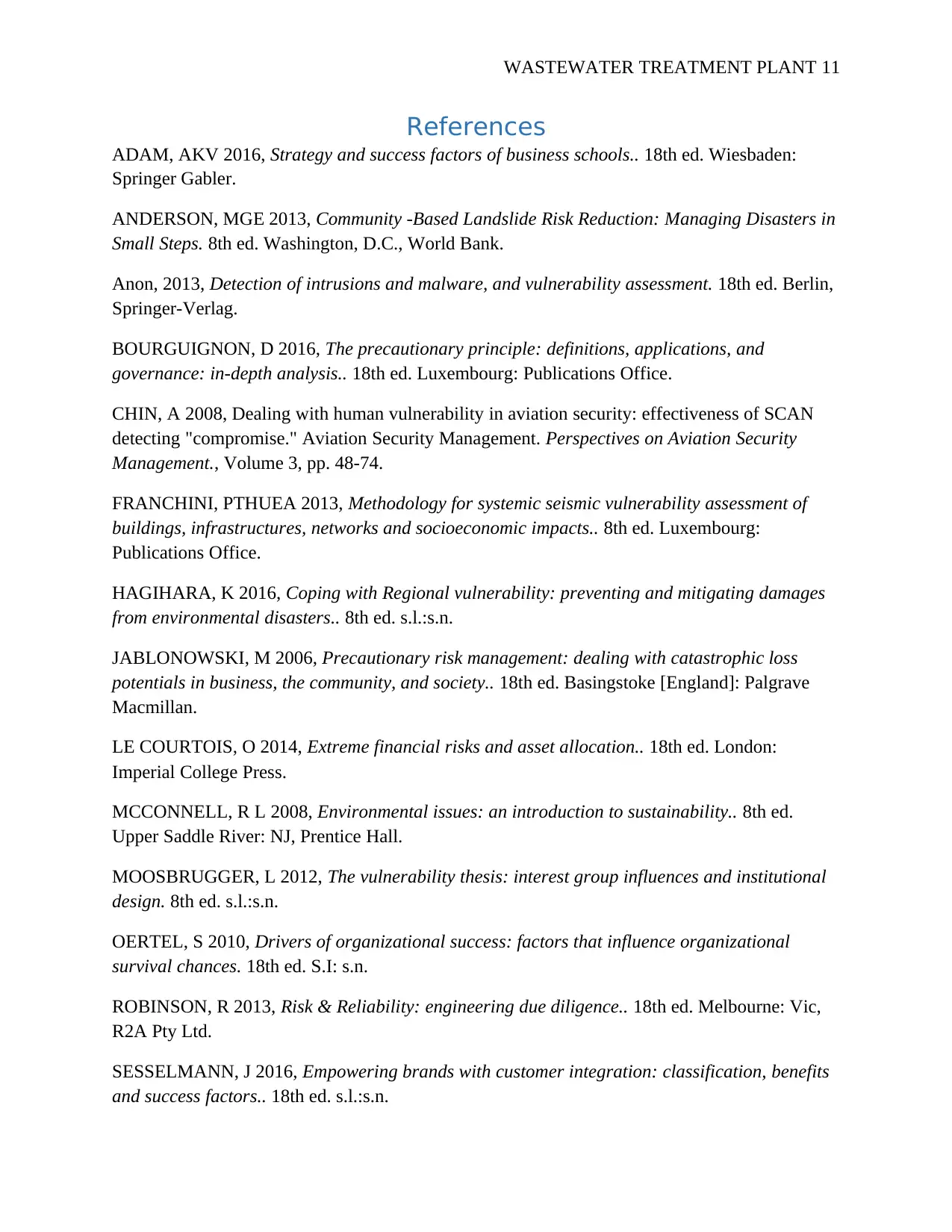
WASTEWATER TREATMENT PLANT 11
References
ADAM, AKV 2016, Strategy and success factors of business schools.. 18th ed. Wiesbaden:
Springer Gabler.
ANDERSON, MGE 2013, Community -Based Landslide Risk Reduction: Managing Disasters in
Small Steps. 8th ed. Washington, D.C., World Bank.
Anon, 2013, Detection of intrusions and malware, and vulnerability assessment. 18th ed. Berlin,
Springer-Verlag.
BOURGUIGNON, D 2016, The precautionary principle: definitions, applications, and
governance: in-depth analysis.. 18th ed. Luxembourg: Publications Office.
CHIN, A 2008, Dealing with human vulnerability in aviation security: effectiveness of SCAN
detecting "compromise." Aviation Security Management. Perspectives on Aviation Security
Management., Volume 3, pp. 48-74.
FRANCHINI, PTHUEA 2013, Methodology for systemic seismic vulnerability assessment of
buildings, infrastructures, networks and socioeconomic impacts.. 8th ed. Luxembourg:
Publications Office.
HAGIHARA, K 2016, Coping with Regional vulnerability: preventing and mitigating damages
from environmental disasters.. 8th ed. s.l.:s.n.
JABLONOWSKI, M 2006, Precautionary risk management: dealing with catastrophic loss
potentials in business, the community, and society.. 18th ed. Basingstoke [England]: Palgrave
Macmillan.
LE COURTOIS, O 2014, Extreme financial risks and asset allocation.. 18th ed. London:
Imperial College Press.
MCCONNELL, R L 2008, Environmental issues: an introduction to sustainability.. 8th ed.
Upper Saddle River: NJ, Prentice Hall.
MOOSBRUGGER, L 2012, The vulnerability thesis: interest group influences and institutional
design. 8th ed. s.l.:s.n.
OERTEL, S 2010, Drivers of organizational success: factors that influence organizational
survival chances. 18th ed. S.I: s.n.
ROBINSON, R 2013, Risk & Reliability: engineering due diligence.. 18th ed. Melbourne: Vic,
R2A Pty Ltd.
SESSELMANN, J 2016, Empowering brands with customer integration: classification, benefits
and success factors.. 18th ed. s.l.:s.n.
References
ADAM, AKV 2016, Strategy and success factors of business schools.. 18th ed. Wiesbaden:
Springer Gabler.
ANDERSON, MGE 2013, Community -Based Landslide Risk Reduction: Managing Disasters in
Small Steps. 8th ed. Washington, D.C., World Bank.
Anon, 2013, Detection of intrusions and malware, and vulnerability assessment. 18th ed. Berlin,
Springer-Verlag.
BOURGUIGNON, D 2016, The precautionary principle: definitions, applications, and
governance: in-depth analysis.. 18th ed. Luxembourg: Publications Office.
CHIN, A 2008, Dealing with human vulnerability in aviation security: effectiveness of SCAN
detecting "compromise." Aviation Security Management. Perspectives on Aviation Security
Management., Volume 3, pp. 48-74.
FRANCHINI, PTHUEA 2013, Methodology for systemic seismic vulnerability assessment of
buildings, infrastructures, networks and socioeconomic impacts.. 8th ed. Luxembourg:
Publications Office.
HAGIHARA, K 2016, Coping with Regional vulnerability: preventing and mitigating damages
from environmental disasters.. 8th ed. s.l.:s.n.
JABLONOWSKI, M 2006, Precautionary risk management: dealing with catastrophic loss
potentials in business, the community, and society.. 18th ed. Basingstoke [England]: Palgrave
Macmillan.
LE COURTOIS, O 2014, Extreme financial risks and asset allocation.. 18th ed. London:
Imperial College Press.
MCCONNELL, R L 2008, Environmental issues: an introduction to sustainability.. 8th ed.
Upper Saddle River: NJ, Prentice Hall.
MOOSBRUGGER, L 2012, The vulnerability thesis: interest group influences and institutional
design. 8th ed. s.l.:s.n.
OERTEL, S 2010, Drivers of organizational success: factors that influence organizational
survival chances. 18th ed. S.I: s.n.
ROBINSON, R 2013, Risk & Reliability: engineering due diligence.. 18th ed. Melbourne: Vic,
R2A Pty Ltd.
SESSELMANN, J 2016, Empowering brands with customer integration: classification, benefits
and success factors.. 18th ed. s.l.:s.n.
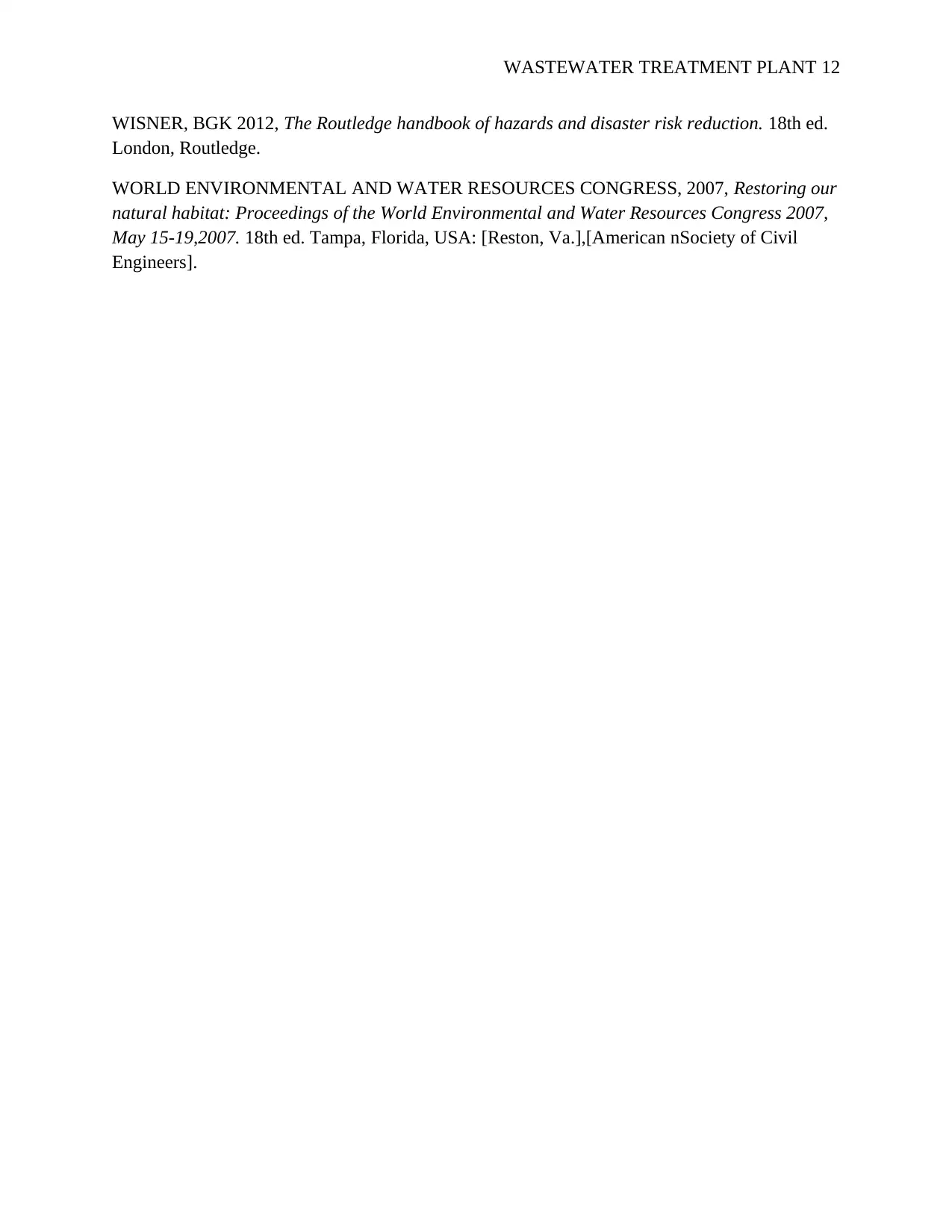
WASTEWATER TREATMENT PLANT 12
WISNER, BGK 2012, The Routledge handbook of hazards and disaster risk reduction. 18th ed.
London, Routledge.
WORLD ENVIRONMENTAL AND WATER RESOURCES CONGRESS, 2007, Restoring our
natural habitat: Proceedings of the World Environmental and Water Resources Congress 2007,
May 15-19,2007. 18th ed. Tampa, Florida, USA: [Reston, Va.],[American nSociety of Civil
Engineers].
WISNER, BGK 2012, The Routledge handbook of hazards and disaster risk reduction. 18th ed.
London, Routledge.
WORLD ENVIRONMENTAL AND WATER RESOURCES CONGRESS, 2007, Restoring our
natural habitat: Proceedings of the World Environmental and Water Resources Congress 2007,
May 15-19,2007. 18th ed. Tampa, Florida, USA: [Reston, Va.],[American nSociety of Civil
Engineers].
⊘ This is a preview!⊘
Do you want full access?
Subscribe today to unlock all pages.

Trusted by 1+ million students worldwide
1 out of 12
Related Documents
Your All-in-One AI-Powered Toolkit for Academic Success.
+13062052269
info@desklib.com
Available 24*7 on WhatsApp / Email
![[object Object]](/_next/static/media/star-bottom.7253800d.svg)
Unlock your academic potential
Copyright © 2020–2025 A2Z Services. All Rights Reserved. Developed and managed by ZUCOL.





